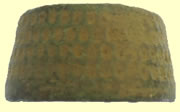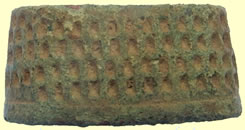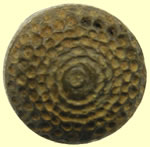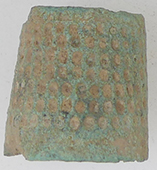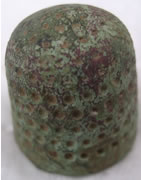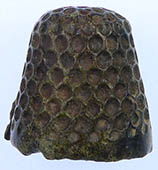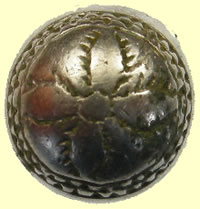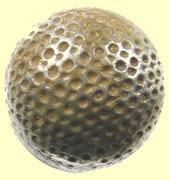

Metal detecting holidays in England with the World's most successful metal detecting club.20 years plus.
Twinned with Midwest Historical Research Society USA.
Thimbles Based on archeological finds near Moscow, 30,000 years ago mammoth hunters created buttons by drilling through pearls made of mammoth ivory. They fashioned bone rings to help them apply pressure while stitching the buttons to leather garments. The modern concept of a thimble comes from the Etruscans living in what is today Italy. They made thimbles from bronze using clay casts. They were difficult to use because the high copper content of the bronze discolored fingers and clothing. In Nürnberg the famous traveling doctor, Dr Paracelcus lived as a sub-tenant in the house of a copper smith. Very curious as to why the copper turned yellow, he researched the problem and discovered that the special earth contained zinc. In a short time, the process was refined to produce pure brass. From then on, the Nürnberg thimbles were no longer cast as a whole but were made from stamped disks and metal strips that were bent conically. The new thimbles were a big success world-wide. Everyone wanted the Nürnberg thimbles because they were better, more comfortable, and cheaper. In order to keep the method of producing brass a secret, the town council of Nürnberg prohibited its thimble makers -- a profession with apprentice, journeyman, and master craftsman -- from leaving the town. For the next 200 years the secret stayed in Nürnberg. |
||||||||||||||||||||||||||||||||||
Medieval beehive thimbles from 12thC |
||||||||||||||||||||||||||||||||||
  |
  |
|||||||||||||||||||||||||||||||||
  |
  |
|||||||||||||||||||||||||||||||||
|
  |
|||||||||||||||||||||||||||||||||
 |
 |
  |
||||||||||||||||||||||||||||||||
 |
 |
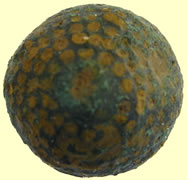  |
||||||||||||||||||||||||||||||||
  |
  |
|||||||||||||||||||||||||||||||||
  |
  |
|||||||||||||||||||||||||||||||||
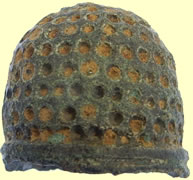  |
  |
|||||||||||||||||||||||||||||||||
 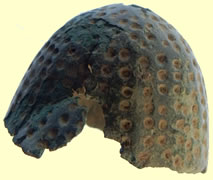 |
  |
|||||||||||||||||||||||||||||||||
  |
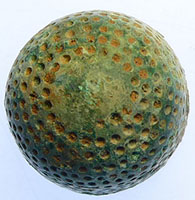  |
|||||||||||||||||||||||||||||||||
  |
  |
|||||||||||||||||||||||||||||||||
  |
  |
|||||||||||||||||||||||||||||||||
  |
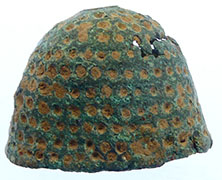 |
|||||||||||||||||||||||||||||||||
  |
  |
|||||||||||||||||||||||||||||||||
  |
||||||||||||||||||||||||||||||||||
15thC Open topped thimbles Like a present-day tailor’s thimble, these sewing rings were clearly designed to apply the pressure sideways. |
||||||||||||||||||||||||||||||||||
    |
||||||||||||||||||||||||||||||||||
     |
||||||||||||||||||||||||||||||||||
 A A    |
||||||||||||||||||||||||||||||||||
     |
||||||||||||||||||||||||||||||||||
    |
||||||||||||||||||||||||||||||||||
|
||||||||||||||||||||||||||||||||||
15thC rim less copper-alloy thimble with an openwork top and small, circular, manually produced indentations. |
||||||||||||||||||||||||||||||||||
Later thimbles post 16thC |
||||||||||||||||||||||||||||||||||
Georgian solid gold thimble 4.67g, 22.75mm H |
||||||||||||||||||||||||||||||||||
 |
  |
 |
|
20thC Cocoa advertising
thimble |
17thC period gilded thimble
|
Very unusual open castle top thimble - post medieval | |
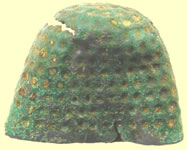   
|
|||
17thC C thimbles |
|||
 |
 |
||
Georgian decorated thimble |
17th & 18thC thimbles |
||
  |
  |
||
| 17thC Dutch type thimble with crest and name | Nurnberg Type ll - mid 16thC thimble | ||
Medieval to Georgian thimbles |
|||
|
|||
Silver thimbles |
|||
Circa 16thC decorated silver thimble - Inscription + FARE GOD -(FEAR GOD) 5.33G, 26mm H |
|||
17th/18th C silver thimble - maker CB - reported as potential treasure to the museum 6.51g,17.72mm H x 16.24mm dia |
|||
  |
 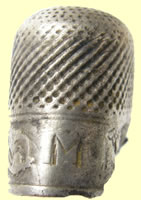 |
||
1901 London hall marked solid silver thimble |
18thC silver thimble - initialed M | ||
  |
  |
||
| Georgian opened topped thimble | 18thC silver thimble - initialed BB | ||
 |
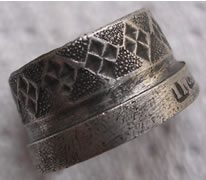  |
||
18thC
decorated silver thimble with initials EC |
Silver
open topped thimble - Chester hallmark 1852 |
||
 |
 |
 |
|
18thC silver thimble marked BB |
18thC
silver thimble |
Large 18thC silver thimble |
|
 |
 |
 |
|
Large 18thC silver thimble |
Georgian
decorated silver thimble |
18thC
silver decorated thimble |
|
  |
 |
||
|
17thC
decorated silver thimble reported as treasure - inscribed BB maker W |
Mid 18thC
silver initial 'AM' |
||
  |
 |
||
Mid 18thC
silver initial 'W' thimble |
18thC
silver thimble |
||
  |
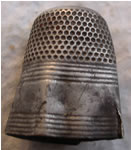 |
||
1898 Birmingham
solid silver hallmarked thimble (b) |
Mid
18thC silver thimble |
||
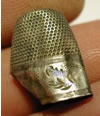 |
 |
 |
|
18thC Decorated
silver thimble |
Mid 18thC
silver thimble |
Early decorated
silver thimble with lions head design |
|
 |
 |
 |
|
18thC
silver decorated thimble |
18thC silver
thimble(r) |
Huge 19thC
silver thimble |
|
 |
 |
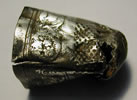 |
|
18thC Decorated
silver thimble |
18thC decorated
silver thimble |
18thC decorated
silver thimble |
|
 |
 |
 |
|
Mid 18thC
silver thimble |
Georgian silver thimble |
Georgian decorated silver thimble |
|
 |
 |
 |
|
Georgian silver thimble |
1864 Silver thimble - Birmingham hall mark - Maker JS - James Swan |
20thC Sterling silver thimble |
|
 |
  |
 |
|
19thc silver thimble - 'KEEPS' |
18thC silver thimble - monogrammed HC | Georgian silver thimble | |
 |
 |
 |
 |
| Georgian decorated silver thimble | Georgian silver thimble | Georgian silver thimble | Victorian silver thimble |
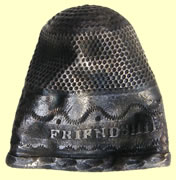  |
 |
 |
|
| Georgian silver thimble - 'Friendship' | Georgian silver thimble | Georgian silver thimble | |
 |
 |
 |
 |
| Victorian silver thimble | Georgian silver thimble | Georgian silver thimble | Victorian silver thimble |
Neat 19thC silver thimble - engraved PAT.G This thimble has another silver liner or another thimble ?
17thC - Very interesting figure of 8 design on this silver thimble Reported as Treasure - matching design in PAS NMS-653275 Treasure case tracking number: 2012T135
Initially before I cleaned this token I thought of a 1640's Civil War siege token but this looks to be middle eastern in origin - sent of to the Fitzwilliam museum for their views, Crusades ? Could just be a fragment off a thimble ? 0.53g, 11.83mm x 14.02mm
|
|||
|
 |
 |
|
| 18thC monogrammed silver thimble | Victorian silver thimble | Georgian silver thimble | |
  |
 |
 |
|
| Georgian silver thimble | Georgian silver thimble | Victorian silver thimble | |
  |
 |
 |
|
| Georgian silver thimble | Georgian silver thimble | Georgian silver thimble | |
 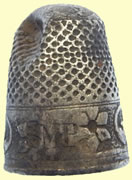 |
  |
||
| Georgian silver thimble | Georgian silver thimble | ||
 |
 |
 |
|
| Victorian silver thimble | Victorian silver thimble | 1875 silver thimble | |
 |
 |
 |
|
| Victorian silver thimble | Victorian silver thimble | Victorian silver thimble | |
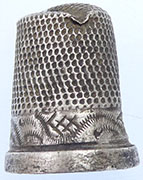 |
 |
  |
|
| Georgian silver thimble | Georgian silver thimble | 20thC silver plated thimble | |
 |
 |
 |
|
| Victorian silver thimble | Victorian silver thimble | Victorian silver thimble | |
 |
 |
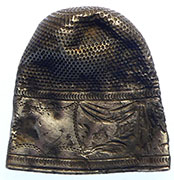 |
|
| Georgian silver thimble | Georgian silver thimble | Victorian silver thimble | |
 |
 |
 |
|
| Victorian silver thimble | Victorian silver thimble | Victorian silver thimble | |
  |
 |
 |
|
| 18thC silver thimble | 1922 silver thimble - Birmingham Maker JS&S J.S &S or JS&S |
Victorian silver thimble | |
 |
  |
||
| 17thC - maker BB - reported as treasure to museum | Georgian monogrammed silver thimble - EO | ||
  |
 |
 |
|
| 1891 silover thimble - London mint date letter Q | Victorian silver thimble | Georgian silver thimble | |
  |
 |
 |
|
| 18thC silver thimble | Victoria silver thimble | Victoria silver thimble | |
  |
 |
||
| Georgian silver thimble - Initialed SR | Victorian silver thimble | ||
 |
|||
| Georgian silver thimbles | |||



















